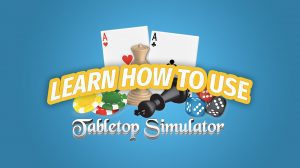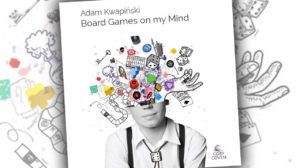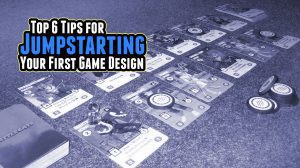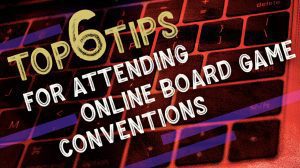While game design does have specific steps like initial concept creation, development, and playtesting, the process for tackling design problems often presents a daunting challenge for the new designer since there is no one correct method. The approach for taking a game through these steps varies greatly among designers. The Game Crafter’s Single Card Challenge is a great opportunity to illustrate this idea. This design contest is basically a challenge to design a game that uses a single playing card. The Game Crafter is a print on demand service for board games used by many designers to make prototypes for their games.
The Game Crafter issued this game design challenge in the Fall of 2022 and gave designers five weeks to meet it. While the design community had a great time sharing ideas, I thought the unique design and time constraints would provide an opportunity to compare and contrast the game development processes of individual designers.
After the contest, I asked those who participated to answer 5 questions about their process for making their single card game. The answers below highlight how they approached the obstacles associated with concept creation, development, and playtesting.
Question 1: What was your inspiration for your single card game design? What is your process for finding inspiration and turning that inspiration into a viable game design concept?
“I tend to think three dimensionally in my game design. I thought a mini golf game with a flicked coin would be fun, so I tried to create a windmill out of a single card with as few cuts and folds as possible. Two cuts and five folds created a perfect little throne instead, and the idea of flicking coins underneath it to appease a greedy gnome king evolved from there.”
– Wylie H
– Washington
“About a week into the challenge, I reworked an old idea that never made it anywhere to create a party drawing game called Ink Well. That required a dry erase marker. I liked it, but as I saw what other designers were doing, I added some additional design restrictions including not allowing any other components. I carried around a poker card with me for a week, just playing with what it could do. I liked the tug-of-war idea, but saw other designers were already using that. I thought about the game where you try to pull your hand away before your opponent slaps it, and wondered if I could translate that to a single card.”
– Brian L
– Frederick, Maryland, USA
“I actually thought it would be impossible to make a single card game, but later that same day I started thinking of something that you could play with some coins. I kind of envisioned myself playing this game with my kids who are very young. I guess with that in mind I went back to my old childhood and pulled some elements of “odds and evens” into the game. It was a super easy game we’d play as kids.”
– Christopher B
– Pennsylvania, USA
Question 2. What tools did you use to create your initial design? What do you like about those tools over other available tools?
“I used Google slides. It’s quite versatile once you know its secrets, but the entry barrier is almost non-existent. I use it daily for work, so it’s handy to use it for game design too.”
– Adrià B
– Barcelona, Spain
“PowerPoint FTW! I’ve used it for years so I’m very familiar with how to make things quickly, and I’ve built lots of templates to help me make certain things faster.”
– Chris B
– Birmingham, England
“Card stock cut up and corners rounded. Pencil to draft the maps. Gives a sense of the game physically, like how the player interacts with it.”
– Andrew D
– New Zealand
“Photoshop and InDesign. I like that I can insert placeholder art, but easily swap it out later for real art. And for this contest I needed the measurements to be exact because there is some cutting that needs to be done to the card, and I want to make sure the art lines up on both sides.”
– Emily W
– Florida, USA
Question 3. Describe your process for playtesting your single card game.
“For playtesting I take my games to work and we play during lunch and morning tea breaks. I have a group of colleagues who all play games so they enjoy testing new games. We can normally get a group of 4 or so together. We brainstorm ideas on an a4 printout of the game and then I make changes and bring in a new version the next day to play.”
– Nick A
– New Zealand
“I used Tabletop Simulator to playtest my game. I tested my initial design on there by randomizing other players actions and choices with random dice rolls. Then I tweaked the rules and powers a bit. Once I felt the game was as far as I could get it on my own, I printed the card out and invited some friends over and played with them.”
– Scott S
– Lompoc, CA
“Made a map. Got a few people to play it. Tuned and repeated until the duration to solve it was just right.”
– Andrew D
– New Zealand
“Print it out at home and take it to the local board game shop to let others try it out.“
– George A
– Scipio, In.
Question 4. Describe your graphic design process. How did you find art for your single card? What was the process you used to decide what art to use?
“The Noun Project for icons and Pixabay for the public domain background.”
– Chris B
– Birmingham, England
“In such a short time I created my own art with photopea and incorporated icons from https://game-icons.net/.”
– Hattie A
– Scipio, In
“I do my own graphic design and create my own art using the Affinity suite. It’s really important to me to have an easy to understand UI with artwork that enriches the experience. Wunkardia was first drawn in my sketchbook and was going to be a fantasy style landscape with ink and watercolor. In the end, though, I used the Affinity suite to mask various colors of watercolor paper, allowing players to easily distinguish between the six areas on the card. I think this was a better choice than the ink and watercolor because it is much less busy in such a limited play area.”
– Lucas G
– Fort Smith, Arkansas
“I used AI for the basic images and then tweaked them in PhotoShop. The dungeon tiles were great fun.”
– Ross M
– Brisbane, Australia
“Paint.NET for the graphic design, I just love it, it’s quick, simple to use and super powerful, and Adobe Premiere Pro since it’s top class editing software.”
– Gabriel Z
– Uruguay
Question 5. Describe the biggest challenge in developing your single card game and how you overcame that challenge.
“Finding a fun, unique idea that required only a single card. I overcame it, by trying new mechanics I had never tried before (dexterity).”
– Patrick B
– Salt Lake City, Utah
“For me, the biggest challenge was finding time to do all the steps of making the card layout and building the TGC shop pages. For these things, the only way out was through. I had to carve out pockets of time and prioritize working on it.”
– Heather N
– Loveland, CO
“The biggest challenge in developing my card game was getting the rules to fit on one side of the card. I wanted to try and pack as much game as I could into the card. I wrestled with so many font sizes and types. This required me to cut a lot of things and I really had to focus on conveying the rules in as few words as possible (which was a great exercise in rules writing).”
– Scott S
– Lompoc, CA
“The game had some clunky gameplay initially. It bothered me and when I shared my design on the Gamecrafter discord channel the answers became clear after getting some input from fellow designers (thanks again Sporktopia_Games and Spocks_Grandpa!). They were really helpful and it’s just nice to get that support from the community.”
– Christopher B
– Pennsylvania, USA
Solving Design Problems
My best advice for new designers to solve any kind of design problem is to understand your resources and find ways to generate new ideas. The game designers who participated in this challenge have a great grasp of the tools that are available to them. I use the term “tools” to mean anything that can be used to help you get through the next stage of game development. A tool can be a piece of software or a group of people.
The designers highlighted above were all able to define the problems that needed to be solved to develop their game. Each was able to figure out what resources they had available and choose one or more tools to solve the problem. A good tool doesn’t need to be expensive. Some designers pay the monthly subscription for Photoshop to create their art and that’s great for them. But other designers choose free graphic software like GIMP. Other designers used graphic software they used for work. Also, don’t forget that people can be a resource too. In at least one case, a designer went to his local game store to find playtesters. Don’t be afraid to approach your local game store or local board gaming group if you need assistance with your design.
The game designers who participated in this challenge all had to find ways to overcome the design challenges. The contest also created some new challenges on top of game design challenges. They all found ways to generate new ideas and many were surprised to find that some ideas that they initially judged as crazy or impossible actually provided the right solution. So I highly recommend finding ways to generate new ideas as you develop your game. You can have brainstorming sessions. You can do “research” by playing games. Pick something that works for you. I’m a big advocate of creating a network of trusted designers. Whenever I have problems to solve, I always bring it to them. Often someone will have a completely different view on a problem and can provide an elegant solution.
Along with finding ways to generate ideas, give yourself time to fully evaluate the idea. Try not to immediately dismiss an idea. Instead ask yourself, “If I tried out that idea, what benefits would that idea have? What would I need to do to make that idea work?” My own games rarely turn out the way I had initially envisioned them. Most of my games involved the implementation of an idea I initially thought was crazy but later turned out to solve more than one issue.
The Designers and Their Games
Below are the links to all the single card games created by all the designers who contributed to this article. While all can be found on The Game Crafter web site not all are for sale. However, each page has a link to a free print and play. So you can try out these games for yourself!
| Adrià B Residence: Barcelona, Spain Single Card Game Name: Finger Fighter https://www.thegamecrafter.com/games/finger-fighter |
| Wylie H Residence: Washington Company: Crystore Inc. Games Single Card Game Name: Dethrone The Gnome https://www.thegamecrafter.com/games/dethrone-the-gnome |
| Gabriel Z Residence: Uruguay Company: FZ Ideas (fzideas.com) Single Card Game Name: Trunk – an Interactive 4th Wall Breaking Movie https://www.thegamecrafter.com/games/trunk |
| Scott S Residence: Lompoc, CA Company: Bacon Fish Games Single Card Game Name: Markets of Meer https://www.thegamecrafter.com/games/markets-of-meer |
| Patrick B Residence: Salt Lake City, Utah Company: New Classic Games (www.newclassicgames.com) Single Card Game Name: One Card Slide https://www.thegamecrafter.com/games/one-card-slide |
| Chris B Residence: Birmingham, England Company: Entro Games, https://entrogames.com Single Card Game Name: Talimens https://www.thegamecrafter.com/games/talimens |
| Heather N Residence: Loveland, CO Company: Protospiel Online and Board Game Bistro Single Card Game Name: Conf-ID-ential Cards and Scandalous Secrets https://thegamecrafter.com/games/conf-id-ential-cards |
| Christopher B Residence: Pennsylvania, USA Company: BilbaoBoardGames Single Card Game Name: UFO, Go! https://www.thegamecrafter.com/games/ufo-go- |
| Andrew D Residence: New Zealand Company: Random Amnesiac, randomamnesiac.com Single Card Game Name: One Card Maze https://www.thegamecrafter.com/games/one-card-maze |
| Emily W Residence: Florida, USA Company: Small Furry Games (e-mail: smallfurrygames@gmail.com) Single Card Game Name: Click-Click, Buzz-Buzz, NOM-NOM! https://www.thegamecrafter.com/games/click-click-buzz-buzz-nom-nom- |
| Brian L Residence: Frederick, Maryland, USA Company: Balaporte Design Single Card Game Name: Five-Finger Gunslinger https://www.thegamecrafter.com/games/five-finger-gunslinger |
| George A Residence: Scipio, In. Company: NOT MY EYEBALL GAMES Single Card Game Name: Downturn https://www.thegamecrafter.com/games/downturn |
| Hattie A Residence: Scipio, In Company: NOT MY EYEBALL GAMES Single Card Game Name: Gold Mountain Mayhem https://www.thegamecrafter.com/games/gold-mountain-mayhem |
| Nick A Residence: New Zealand Company: Piracy Boardgames Single Card Game Name: Zom-Boy+ https://www.thegamecrafter.com/games/zom-boy- |
| Lucas G Residence: Fort Smith, Arkansas Company: Gerlach Games Single Card Game Name: War for Wunkardia, Rescue the Creature https://www.thegamecrafter.com/games/war-for-wunkardia |
| Ross M Residence: Brisbane, Australia Company: LarkspurGames.com Single Card Game Name: One Card Labyrinth Https://www.thegamecrafter.com/games/one-card-labyrinth |











Add Comment